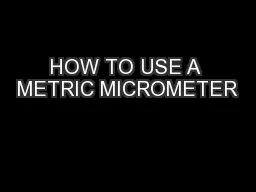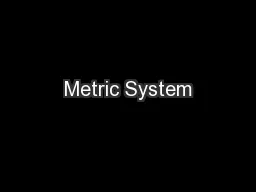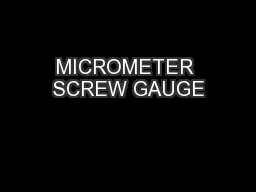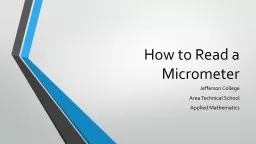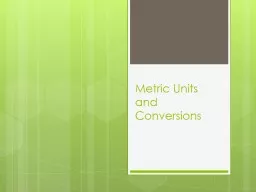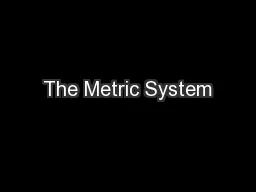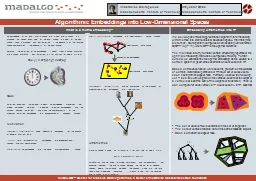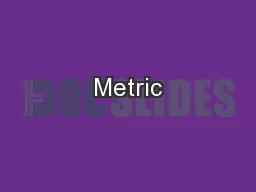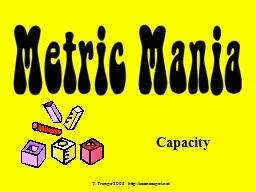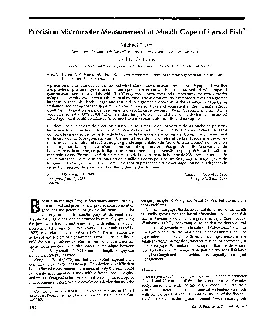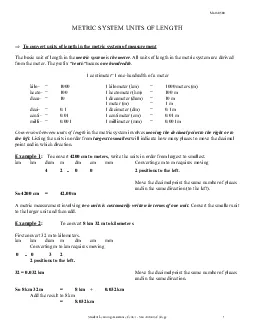PDF-HOW TO USE A METRIC MICROMETER
Author : phoebe-click | Published Date : 2015-09-05
The metric micrometer looks very similar to a standard inch micrometer until you look at the graduations on the sleeve and the barrel Figure 1 Figure 1 025 millimeter
Presentation Embed Code
Download Presentation
Download Presentation The PPT/PDF document "HOW TO USE A METRIC MICROMETER" is the property of its rightful owner. Permission is granted to download and print the materials on this website for personal, non-commercial use only, and to display it on your personal computer provided you do not modify the materials and that you retain all copyright notices contained in the materials. By downloading content from our website, you accept the terms of this agreement.
HOW TO USE A METRIC MICROMETER: Transcript
The metric micrometer looks very similar to a standard inch micrometer until you look at the graduations on the sleeve and the barrel Figure 1 Figure 1 025 millimeter. S 1 ft 12 in 1 yard 3 ft 1 mile 5280 ft 1 cup 8 64258 oz 1 pint 2 cups 1 qt 4 cups 2 pints 1 gallon 4 qts 1 lb 16 oz MetricUS 1 in 254 cm 1 yd 0914 m 1 km 0621 miles 1 kg 220 lb 454 g 1 lb 1 ton 9072 kg 1 grain 0000065 kg 946 mL 1 qt Why do scientists need a standard system of measurements?. Remember that science must be . repeatable. – another scientist has to able to repeat your experiment using the same amounts, concentrations, lengths, weights, etc.. Happy Monday!. Warm-up sheet explanation and set-up. Warm-up. Pass out Metric System Unit Objectives. Warm Up (8-24-15). Please get out your warm up sheet and answer the . following questions.. Write down 3 things you know about the metric system.. Mohammad . Dedyardie. . Takong. 08B0904. Student’s Lesson Objective:. At the end of the lesson, you should be able to:. State the use of a micrometer screw gauge. Master the techniques in using a micrometer screw gauge. Jefferson College. Area Technical School. Applied Mathematics. The Micrometer. . A micrometer generally provides . greater precision . than a caliper, but . can measure . a smaller range of lengths.. A.S. 1.1.1 – 1.1.3. Is the US a metric country? Should it be?. Read the article you’ve been handed with these two questions in mind.. 5. minutes—. silent . read and take notes.. Turn and talk to your group members (you all had the same article)—2 minutes. ~King Henry Died unexpectedly Drinking Chocolate Milk~. Unlike our . English system . of measurement with its feet and inches, quarts and gallons, . the . metric system is very . orderly . All . variations of the units of measure are really just the units multiplied by powers of 10. . embedding?. Embedding . ultrametrics. into R. d. An embedding of an input metric space into a host metric space is a mapping that sends each point of the input space to a point of the host space. Such a mapping has low distortion if the geometry of the resulting space approximates the geometry of the input space.. T. Trimpe 2008 http://sciencespot.net/. So How Do I Do A Metric Conversion?. We will be using a method called The Stair-step Method of Metric Conversion.. It requires two things; one, that you be able to count to 6, and two, that you know your left from your right.. Measurements. It is important. that . measurements. be accurate &. easily . communicated. to other people. The scientific. system of. measurement. is called the. metric system. Scientists . Use metric . Capacity. Capacity refers to how much something can hold or how much space it takes up. We can measure the capacity of regular object using the formula . length x width x height. .. 10 cm. 9 cm. 8 cm. FIG measuring comes and micrometer are mounted in the micrometer and are locked brass set-screws In a set six interchange- measuring rods were the conical tips an accuracy of 8005 mm their nominal tip The basic unit of length in the metric system All units of length in the metric system are derivedone hundredth1 centimeter1 one-hundredth of a meter10001 kilometer km1000 meters mhecto-1001 hectomete 16. th. Marcel Grossmann Meeting. July 5 – 10, 2021. David Lucchesi. , Luciano Anselmo, Massimo Bassan, Marco Lucente, Carmelo . Magnafico. , Carmen Pardini, Roberto Peron, Giuseppe . Pucacco. , Feliciana Sapio, Massimo Visco.
Download Document
Here is the link to download the presentation.
"HOW TO USE A METRIC MICROMETER"The content belongs to its owner. You may download and print it for personal use, without modification, and keep all copyright notices. By downloading, you agree to these terms.
Related Documents

